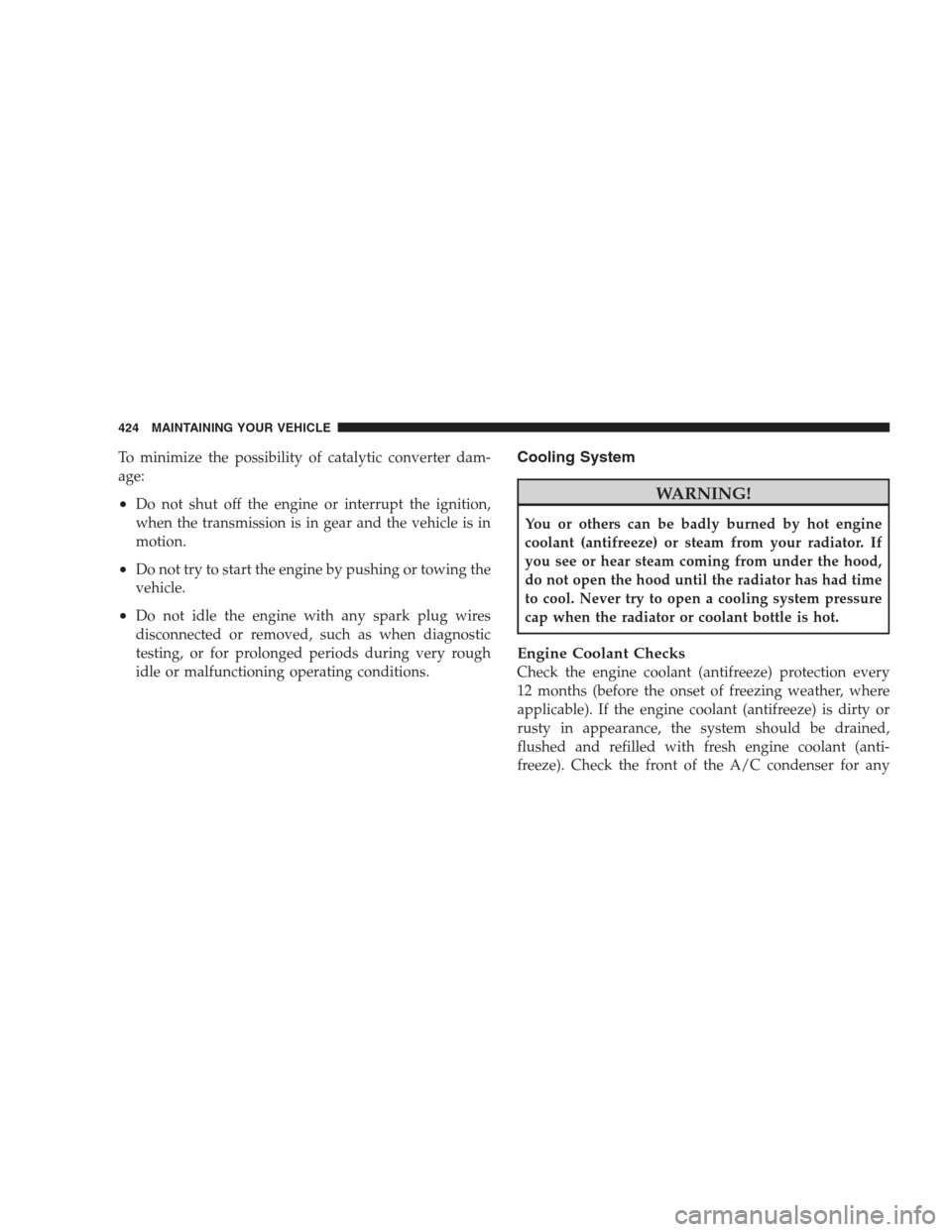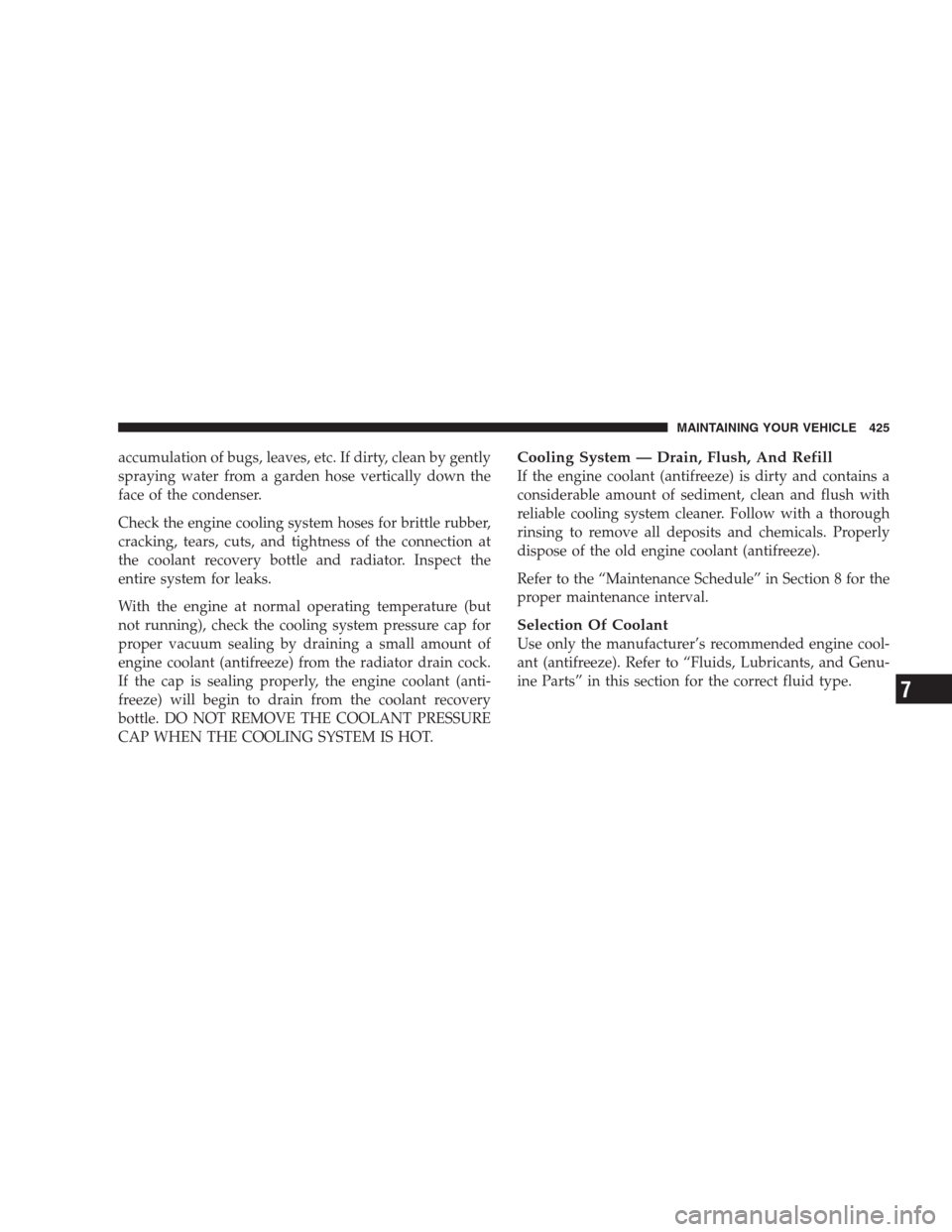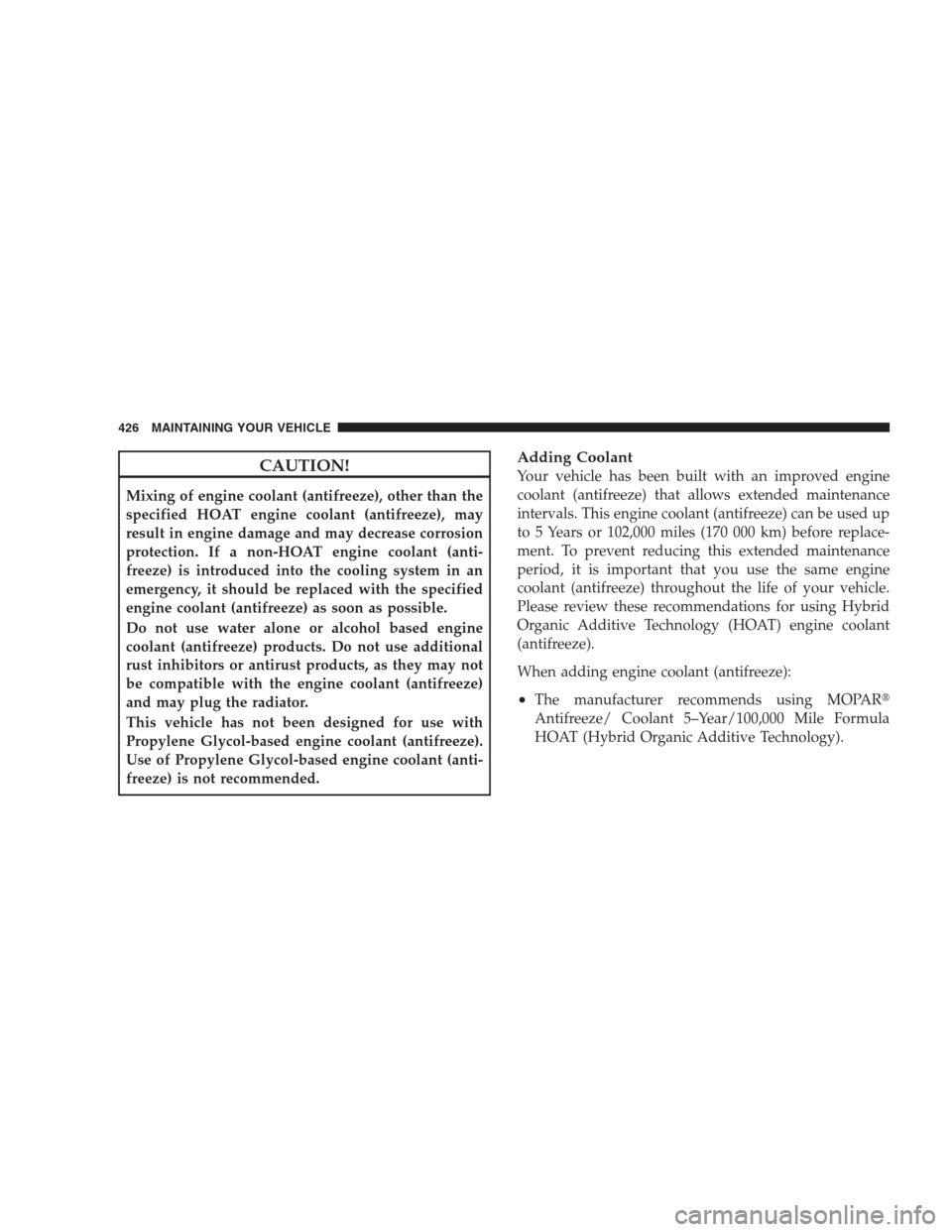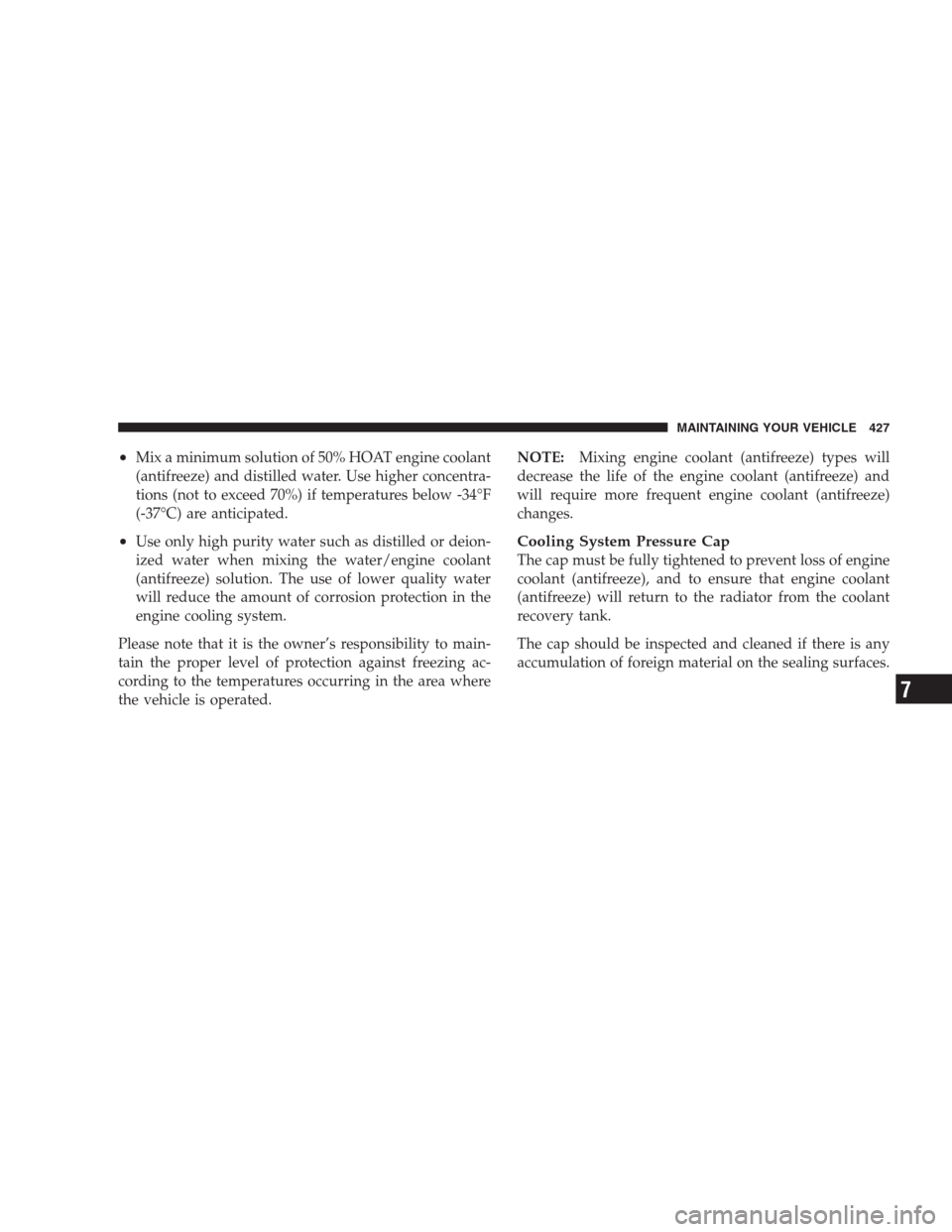Page 408 of 521
ENGINE COMPARTMENT – 3.7L
1 — Engine Coolant Reservoir 6 — Battery
2 — Engine Oil Dipstick 7 — Washer Fluid Reservoir
3 — Power Distribution Center 8 — Engine Oil Fill
4 — Brake Fluid Reservoir 9 — Coolant Pressure Cap
5 — Integrated Power Module 10 — Air Cleaner Filter 406 MAINTAINING YOUR VEHICLE
Page 409 of 521
ENGINE COMPARTMENT – 4.7L
1 — Engine Coolant Reservoir 7 — Battery
2 — Automatic Transmission Dipstick 8 — Washer Fluid Reservoir
3 — Engine Oil Dipstick 9 — Engine Oil Fill
4 — Power Distribution Center 10 — Coolant Pressure Cap
5 — Brake Fluid Reservoir 11 — Air Cleaner Filter
6 — Integrated Power ModuleMAINTAINING YOUR VEHICLE 407
7
Page 410 of 521
ENGINE COMPARTMENT – 5.7L
1 — Engine Coolant Reservoir 7 — Washer Fluid Reservoir
2 — Automatic Transmission Dipstick 8 — Engine Oil Dipstick
3 — Power Distribution Center 9 — Engine Oil Fill
4 — Brake Fluid Reservoir 10 — Coolant Pressure Cap
5 — Integrated Power Module 11 — Air Cleaner Filter
6 — Battery 408 MAINTAINING YOUR VEHICLE
Page 411 of 521
ENGINE COMPARTMENT – 3.0L DIESEL
1 — Engine Coolant Reservoir 6 — Washer Fluid Reservoir
2 — Power Distribution Center 7 — Engine Oil Fill
3 — Brake Fluid Reservoir 8 — Engine Oil Dipstick
4 — Integrated Power Module 9 — Engine Air Cleaner Filter
5 — BatteryMAINTAINING YOUR VEHICLE 409
7
Page 426 of 521

To minimize the possibility of catalytic converter dam-
age:
•Do not shut off the engine or interrupt the ignition,
when the transmission is in gear and the vehicle is in
motion.
•Do not try to start the engine by pushing or towing the
vehicle.
•Do not idle the engine with any spark plug wires
disconnected or removed, such as when diagnostic
testing, or for prolonged periods during very rough
idle or malfunctioning operating conditions.
Cooling System
WARNING!
You or others can be badly burned by hot engine
coolant (antifreeze) or steam from your radiator. If
you see or hear steam coming from under the hood,
do not open the hood until the radiator has had time
to cool. Never try to open a cooling system pressure
cap when the radiator or coolant bottle is hot.
Engine Coolant Checks
Check the engine coolant (antifreeze) protection every
12 months (before the onset of freezing weather, where
applicable). If the engine coolant (antifreeze) is dirty or
rusty in appearance, the system should be drained,
flushed and refilled with fresh engine coolant (anti-
freeze). Check the front of the A/C condenser for any
424 MAINTAINING YOUR VEHICLE
Page 427 of 521

accumulation of bugs, leaves, etc. If dirty, clean by gently
spraying water from a garden hose vertically down the
face of the condenser.
Check the engine cooling system hoses for brittle rubber,
cracking, tears, cuts, and tightness of the connection at
the coolant recovery bottle and radiator. Inspect the
entire system for leaks.
With the engine at normal operating temperature (but
not running), check the cooling system pressure cap for
proper vacuum sealing by draining a small amount of
engine coolant (antifreeze) from the radiator drain cock.
If the cap is sealing properly, the engine coolant (anti-
freeze) will begin to drain from the coolant recovery
bottle. DO NOT REMOVE THE COOLANT PRESSURE
CAP WHEN THE COOLING SYSTEM IS HOT.Cooling System — Drain, Flush, And Refill
If the engine coolant (antifreeze) is dirty and contains a
considerable amount of sediment, clean and flush with
reliable cooling system cleaner. Follow with a thorough
rinsing to remove all deposits and chemicals. Properly
dispose of the old engine coolant (antifreeze).
Refer to the “Maintenance Schedule” in Section 8 for the
proper maintenance interval.
Selection Of Coolant
Use only the manufacturer’s recommended engine cool-
ant (antifreeze). Refer to “Fluids, Lubricants, and Genu-
ine Parts” in this section for the correct fluid type.
MAINTAINING YOUR VEHICLE 425
7
Page 428 of 521

CAUTION!
Mixing of engine coolant (antifreeze), other than the
specified HOAT engine coolant (antifreeze), may
result in engine damage and may decrease corrosion
protection. If a non-HOAT engine coolant (anti-
freeze) is introduced into the cooling system in an
emergency, it should be replaced with the specified
engine coolant (antifreeze) as soon as possible.
Do not use water alone or alcohol based engine
coolant (antifreeze) products. Do not use additional
rust inhibitors or antirust products, as they may not
be compatible with the engine coolant (antifreeze)
and may plug the radiator.
This vehicle has not been designed for use with
Propylene Glycol-based engine coolant (antifreeze).
Use of Propylene Glycol-based engine coolant (anti-
freeze) is not recommended.
Adding Coolant
Your vehicle has been built with an improved engine
coolant (antifreeze) that allows extended maintenance
intervals. This engine coolant (antifreeze) can be used up
to 5 Years or 102,000 miles (170 000 km) before replace-
ment. To prevent reducing this extended maintenance
period, it is important that you use the same engine
coolant (antifreeze) throughout the life of your vehicle.
Please review these recommendations for using Hybrid
Organic Additive Technology (HOAT) engine coolant
(antifreeze).
When adding engine coolant (antifreeze):
•The manufacturer recommends using MOPAR�
Antifreeze/ Coolant 5–Year/100,000 Mile Formula
HOAT (Hybrid Organic Additive Technology).
426 MAINTAINING YOUR VEHICLE
Page 429 of 521

•Mix a minimum solution of 50% HOAT engine coolant
(antifreeze) and distilled water. Use higher concentra-
tions (not to exceed 70%) if temperatures below -34°F
(-37°C) are anticipated.
•Use only high purity water such as distilled or deion-
ized water when mixing the water/engine coolant
(antifreeze) solution. The use of lower quality water
will reduce the amount of corrosion protection in the
engine cooling system.
Please note that it is the owner’s responsibility to main-
tain the proper level of protection against freezing ac-
cording to the temperatures occurring in the area where
the vehicle is operated.NOTE:Mixing engine coolant (antifreeze) types will
decrease the life of the engine coolant (antifreeze) and
will require more frequent engine coolant (antifreeze)
changes.Cooling System Pressure Cap
The cap must be fully tightened to prevent loss of engine
coolant (antifreeze), and to ensure that engine coolant
(antifreeze) will return to the radiator from the coolant
recovery tank.
The cap should be inspected and cleaned if there is any
accumulation of foreign material on the sealing surfaces.
MAINTAINING YOUR VEHICLE 427
7